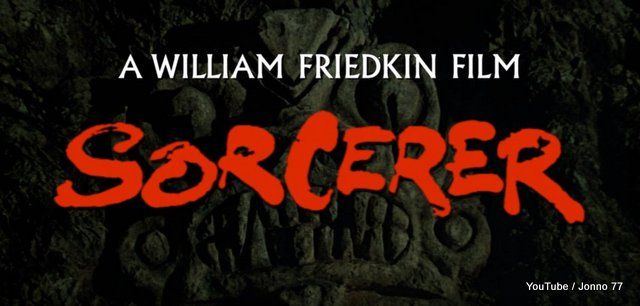On March 18th at 12pm, Bristol's Watershed screens 'Sorceror', the underrated movie scored by German synth rock band Tangerine Dream. By Oliver Goddard.
As part of Filmic 2018, their annual celebration of music and movies, Watershed are screening a selection of sci-fi films and thrillers with idiosyncratic scores. There is a chance to revisit the late Jóhann Jóhannsson’s mesmerising work for Denis Villeneuve’s Arrival, and to reacquaint oneself with some more familiar faces, such as Bernard Herrmann, Jerry Goldsmith and Hans Zimmer.
Buried among these usual suspects is a more striking inclusion: William Friedkin’s Sorcerer (1977), scored by krautrockers Tangerine Dream. Friedkin’s remake of the Henri-Georges Clouzot’s suspense classic The Wages of Fear (1953) marked the German band’s first foray into the form. A few years later they contributed equally essential work to Michael Mann’s debut thriller Thief (1981) - currently streaming on Netflix UK - and perhaps somewhat more inexplicably scored Tom Cruise’s breakout film Risky Business (1983).

Their first effort remains their most compelling work, at once jarring with the lush yet brutal on-screen imagery whilst complementing the film’s pitch-black pessimism. Electronic bands with prog-rock inflections were certainly no strangers to European cinema of the 1960s and 70s. Popol Vuh contributed mysterious soundscapes to the early work of German New-Wave master Werner Herzog, with Aguirre, the Wrath of God (1972) perhaps being their best work. Italian outfit Goblin similarly cut their teeth writing soundtracks to the giallo films of Dario Argento. Their somewhat funky yet unnerving compositions, a marriage of both synthesised and organic instrumentation, added a sense of propulsive momentum to Hitchcockian slasher Profondo Rosso (1975).
They later refined their sound with their now-iconic score to Suspiria (1977). Their timbre was now more reliant on synthesizers and looping electronics, which complimented both the film’s intensity and its brazen use of colour. On the other side of the Atlantic, however, such synth-driven soundtracks were rare, particularly with regards to big budget studio pictures. There was the odd exception, such as Wendy Carlos’ score for Stanley Kubrick’s A Clockwork Orange (1971), but otherwise such scores were more commonplace in independently financed movies, such as John
Carpenter’s Dark Star (1974).
Tangerine Dream’s electronics offer a dramatic counterpoint to the realism Friedkin so effectively generates [in Sorceror]
Sorcerer, on the other hand, was a studio movie with studio financing. Hot off two critical and box-office smashes, The French Connection (1971) and The Exorcist (1973), Friedkin pretty much had carte blanche with his next project. He chose to adapt Georges Arnaud’s novel The Wages of Fear, a tale of a ragtag group of four men tasked with transporting two truck-loads of lethally unstable nitroglycerin across treacherous terrain. The project could not have been any less commercial; shot on location in the jungle of the Dominican Republic, with no big-name box-office stars, and with a lengthy, almost cinema verité prologue that alienated US audiences from the outset due to the lack of English dialogue.
The shoot was equally challenging. Blighted by crew illnesses, extreme weather conditions and unaccommodating locations, Sorcerer is of a piece with Apocalypse Now and Fitzcarraldo as a film that inexplicably remained coherent in spite of the immense challenges faced during production.
And yet the challenge of the shoot translated into some of the most remarkably visceral imagery of 1970s American cinema, with Tangerine Dream’s electronics offering a dramatic counterpoint to the realism Friedkin so effectively generates. It is an unapologetically loud film, with the diegetic sounds of rattling engines and deafening explosions competing in a loudness war with Tangerine Dream’s wall of synths. The score disappears into the background at critical junctures, which only heightens the unbearable tension. One such instance of this, the grueling river-crossing centrepiece, remains one of the most unbearably tense set-pieces of modern moviemaking, in no small part due to the stark sound design.
Though Sorcerer was certainly action-packed, moviegoers in 1977 failed to respond to Friedkin’s nihilistic world view. Famously, it was buried at the box-office by a little film by the name of Star Wars. George Lucas’ space melodrama of good-versus-evil was clearly more palatable to audiences of the day. A box-office bomb on its initial release, Sorcerer has grown in critical stature over the years, with many now considering it one of the most underrated films of the 1970s.
Whilst perhaps not necessarily the best movie to come out of the American New-Wave, it nevertheless was one of the movement’s most characteristic films, and certainly remains one of the most dour and misanthropic movies ever to get major studio backing - and Tangerine Dream’s score remains singular and unsettling to this day. See it loud.
Like what you read? Read more from Oliver on Twitter @OhMaGoddard
Picture credit: YouTube / Jonno 77








